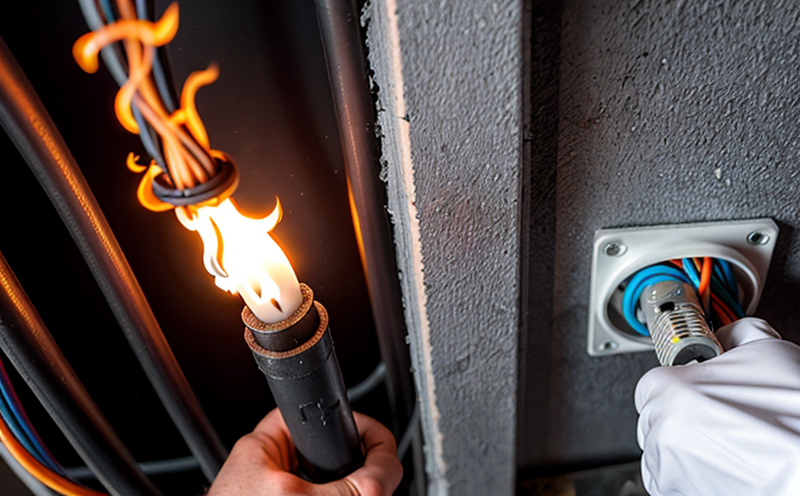Electrical and Thermal Aging Effect on Cable Flammability
The electrical and thermal aging effect on cable flammability is a critical aspect in ensuring the safety and reliability of electrical systems. As cables age, they undergo various changes that can impact their ability to resist ignition and flame propagation. This service focuses on evaluating how these factors influence the overall performance and fire resistance of cables.
Electrical aging typically results from the degradation caused by high voltage stress, which leads to insulation breakdown and eventual failure over time. Thermal aging, conversely, is primarily due to prolonged exposure to elevated temperatures that can cause chemical changes in the cable insulation material, reducing its mechanical strength and fire resistance properties. These processes are accelerated under real-world conditions such as overloading or environmental stresses.
Understanding these effects is essential for quality managers, compliance officers, R&D engineers, and procurement professionals who need to ensure that cables meet stringent safety standards and perform reliably throughout their lifecycle. By accurately assessing the impact of electrical and thermal aging on cable flammability, we can provide insights into potential risks and develop strategies to mitigate them.
Our testing methodology involves subjecting samples to controlled environments that simulate both electrical and thermal stresses. This allows us to observe changes in physical properties like tensile strength, elongation at break, and heat deflection temperature (HDT). Additionally, we conduct flame tests to measure the cable's resistance to ignition and its ability to self-extinguish once exposed to a fire source.
The results of these tests are analyzed using advanced analytical techniques such as Fourier Transform Infrared Spectroscopy (FTIR), Differential Scanning Calorimetry (DSC), and thermogravimetric analysis (TGA). These methods help us quantify the extent of degradation due to aging, providing a comprehensive understanding of the cable's current state.
Our findings are then used to recommend appropriate actions such as upgrading insulation materials or implementing preventive maintenance practices. This ensures that electrical systems remain safe and compliant with relevant international standards like ISO 17692-3:2014 for thermoplastic insulated power cables.
Why It Matters
The importance of addressing the effects of electrical and thermal aging on cable flammability cannot be overstated. In industrial settings, where large-scale electrical systems are common, even minor failures can lead to catastrophic consequences including fires, equipment damage, and personnel injuries.
- Enhanced Safety: By understanding how cables age over time, we can identify vulnerabilities early on and take proactive measures to prevent accidents.
- Compliance with Standards: Meeting regulatory requirements is crucial for maintaining business operations. Our testing ensures that your products comply with international standards such as IEC 60332-1:2004 which specifies the test methods and criteria for ignitability of cables.
- Prolonged Lifespan: Knowing the impact of aging allows manufacturers to design more durable and long-lasting products, increasing customer satisfaction and brand loyalty.
- Economic Efficiency: Preventative maintenance based on our test results helps avoid costly repairs or replacements down the line.
In summary, this service plays a vital role in safeguarding lives and property while ensuring compliance with industry best practices. It contributes significantly to achieving sustainable development goals by promoting safer, more efficient electrical systems worldwide.
Benefits
The benefits of our Electrical and Thermal Aging Effect on Cable Flammability testing extend beyond mere compliance; they offer tangible advantages that contribute positively to various aspects of business operations:
- Increased Safety: By accurately assessing the effects of aging, we ensure that electrical systems operate safely without posing risks to personnel or surrounding areas.
- Economic Savings: Preventive maintenance recommendations derived from our tests help businesses avoid unexpected downtime and repair costs associated with failed equipment.
- Better Product Quality: Understanding the aging process enables manufacturers to improve product design and formulation, leading to higher quality output.
- Enhanced Reputation: Demonstrating commitment to safety and compliance enhances a company's reputation among customers, stakeholders, and regulatory bodies alike.
In addition to these direct benefits, this service also fosters innovation within organizations by encouraging continuous improvement in product development processes. As technology advances, so too must our understanding of how materials behave under different conditions; our testing helps pave the way for future innovations that will further enhance electrical safety and performance.
Quality and Reliability Assurance
To ensure high levels of accuracy and reliability in our testing, we adhere strictly to internationally recognized standards such as ISO 17692-3:2014 for thermoplastic insulated power cables. These guidelines provide a framework within which all aspects of the test procedure are conducted consistently across multiple laboratories.
Our laboratory uses state-of-the-art equipment like high-voltage testing units, differential scanning calorimeters (DSC), and Fourier Transform Infrared Spectrometers (FTIR) to perform precise measurements during both electrical and thermal aging simulations. Each sample is carefully prepared according to standard procedures outlined in the relevant international standards.
Once exposed to controlled environments simulating real-world conditions, specimens undergo rigorous observation and measurement. Data collected includes but is not limited to changes in tensile strength, elongation at break, heat deflection temperature (HDT), smoke density, and flame spread rate.
- Tensile Strength: Measured using universal testing machines equipped with appropriate fixtures suitable for small gauge materials like wires or larger cross-sectional areas found in cable assemblies.
- Elongation at Break: Determined through tensile tests where the specimen is stretched until it breaks, allowing us to calculate percentage elongation before failure occurs.
- Heat Deflection Temperature (HDT): Obtained by heating a sample under specified load conditions until it deforms permanently according to ISO guidelines.
- Smoke Density: Assessed using smoke density meters that measure the amount of light absorbed or transmitted through smoke generated by burning specimens.
- Flame Spread Rate: Measured using flame spread testers which quantify how quickly flames spread along a horizontal surface carrying the sample.
The collected data is analyzed statistically to determine trends and patterns indicative of aging effects. This information forms the basis for our recommendations regarding material selection, process optimization, and product lifecycle management strategies aimed at enhancing overall quality assurance practices within your organization.





